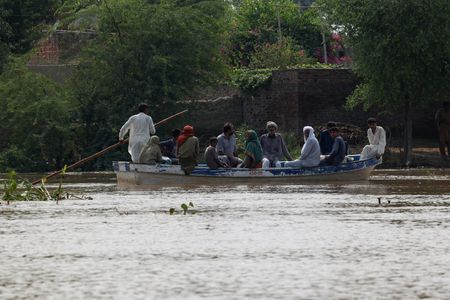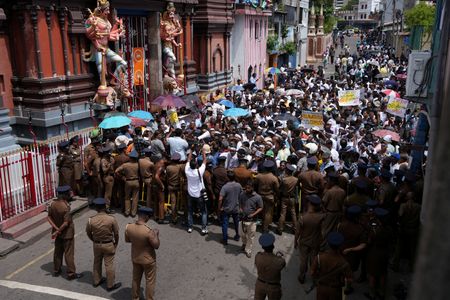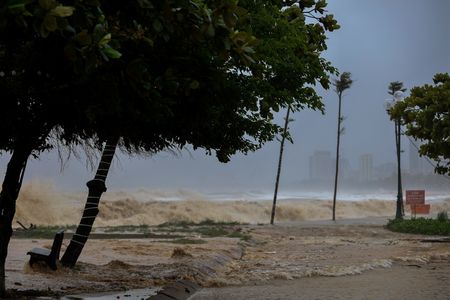By Asif Shahzad
LAHORE, Pakistan (Reuters) -Pakistan said on Tuesday its Punjab region, including the second largest city of Lahore, faced a “very high to exceptionally high” danger of flooding due to a combination of heavy rains and India’s decision to release waters from two dams.
Arch-rivals India and Pakistan have been ravaged by intense monsoon rains and flooding in recent weeks. The release of excess water from India’s dams threatens to further flood parts of Pakistan’s Punjab province, which serves as the country’s breadbasket and is home to half of its 240 million people.
The nuclear-armed nations have been in a tense stand-off since a brief conflict in May, their worst fighting in decades, and any flooding blamed on India could inflame ties.
Pakistan’s Provincial Disaster Management Authority said late on Tuesday that India had opened all the gates of its Thein Dam on the Ravi River. India’s water resources ministry did not immediately respond to a request for comment.
The announcement came a day after Pakistan received a second warning from India that it intended to release water from the rapidly filling Madhopur Dam. Both dams are located on the Ravi River, which flows from Indian Punjab into Pakistan.
“The flood situation is grave,” said Irfan Ali Kathia, an official at the authority in Punjab. “The next 48 hours will be critical.”
Earlier, a spokesperson for Pakistan’s National Disaster Management Authority said its assessment of satellite pictures of Thein Dam showed that it was 97% full and could release water at any time.
India routinely releases water from its dams when they get too full, with the excess flowing into Pakistan, as the two nations share rivers. Punjab province was split between the two countries when they gained independence in 1947.
Earlier in the day, an Indian government source said they had not mentioned a specific dam but that the intense rain had led them to share the second warning in two days with Pakistan, through diplomatic channels. Asked if more warnings could be issued, the source said it was possible.
Another Indian source said New Delhi was sharing the information with Islamabad on “humanitarian grounds” to help avert catastrophe as the rains have caused havoc in India too.
EVACUATIONS
Pakistan started forced evacuations on Friday. The number of displaced people in Pakistani Punjab now exceeds 150,000, including nearly 35,000 people who left voluntarily following flood warnings since August 14, the national authority said.
Authorities are evacuating people from hundreds of villages in the vicinity of three rivers – the Ravi, Sutlej and Chenab – in Punjab province and evacuations are continuing, helped by army troops, it said.
The three rivers are so far seeing medium to high flooding, though further heavy rainfall is expected in both Punjab and Pakistani Kashmir in the next 12 to 24 hours, officials said.
Sixteen villages are currently at risk of flooding, said Deputy Commissioner Saba Asghar Ali after visiting Pasrur city near the Indian border.
Arrangements for food, medicines, washrooms, and other necessities have been made in relief camps set up in the area, she said.
“Due to climate change, eastern rivers are experiencing heavier rainfall compared to the past,” said Kazim Raza Pirzada, the Punjab province irrigation minister.
The death toll caused by flooding in Pakistan since the start of the monsoon season in late June now stands at 802, half of them in this month alone. An estimated 68 people have died in Indian Kashmir this month, including eight on Tuesday.
The northern Pakistani region of Gilgit Baltistan has suffered accelerated glacial melting, while the southern city of Karachi was partly submerged by floods last week.
(Reporting by Mubasher Bukhari in Lahore and Asif Shahzad in Islamabad; Additional reporting by Krishna N Das and Sakshi Dayal in New Delhi; Editing by Saad Sayeed and Sophie Walker)










